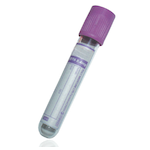Suitable Specimen Types
- EDTA Whole Blood
Sample Processing in Laboratory
Place in Trace Element rack in Send Away Fridge.Sample Preparation
Blood is preferred sample. No need to centrifuge.
Turnaround Time
10 daysSample Stability
UsualLead
General Information
Lead is a non-essential element. Toxic effects resulting from its extensive use in silver smelting, paint production, jewellery making, ceramic glazes, building construction, and in drinking vessels and water supply systems have been known for many hundreds of years. During the last 150 years the industrial use of lead has increased enormously and since the mid-1920s the use of alkyl lead derivatives as anti-knock agents in petrol has caused a further massive increase in distribution, only recently curbed by the substitution of ‘unleaded’ petrol.
Through the introduction of stringent safety precautions in industry, and regulations limiting the amount of lead in paints, the number of cases of severe inorganic lead poisoning has fallen dramatically. Isolated instances of toxicity, both industrial and non-occupational, do however occur, with symptoms of abdominal pain, fatigue, weakness, anaemia, basophilic stippling of erythrocytes, and peripheral neuropathy. Rarely, a blue line in the gums is seen and chronic renal failure may occur. Radiological examination may reveal radiopaque material in the abdomen and bands of increased density (‘lead lines’) in the bones. In children, severe effects are more common and may lead to encephalopathy and death.
Despite widespread use of tetramethyl and tetraethyl lead in the petroleum industry cases of direct toxicity from absorption of these compounds are relatively rare. The pathological picture differs considerably from inorganic lead toxicity in that neurological signs such as encephalopathy, delirium, confusion, anorexia, vomiting, weakness and fatigue predominate. Cases may arise however from activities such as petrol sniffing by young people, although the situation is complicated by the toxic effects of the petroleum hydrocarbon.
Although cases of severe lead toxicity still occur, increasing anxiety has been expressed in recent years over the possible effects of prolonged sub-clinical lead exposure on neurobehavioural development. In certain areas of the country, the combination of soft water and extensive use of lead plumbing and storage tanks has caused particular concern; slightly acidic water may also leach lead from badly soldered copper supply pipes. Pica, the repetitive ingestion of non-food substances by young children, may present a hazard in poorly maintained housing with lead-based paint.
Measures such as the removal of tin-lead solder from food cans and the control of lead levels in paints have helped over the last 15 – 20 years to reduce environmental exposure to lead. There seems little doubt, however, from the results of studies comparing subjects in light and heavy traffic areas of the UK, that the increasing use of lead free petrol has resulted in a very significant fall in the blood lead levels in populations exposed to traffic emissions.
The traditional remedies of a number of ethnic groups may contain substantial amounts of lead and several instances of clinical lead poisoning by ingestion of Asian traditional remedies have been reported in the U.K. Middle Eastern and Asian eye cosmetics may also contain lead, and their use on infants or by their mothers is associated with increased blood lead levels in the infants concerned.
Blood lead assay is the measurement of choice for the assessment of exposure to inorganic lead as 95% of the blood lead is bound to erythrocytes. For assessment of exposure to organic lead derivatives however, urinary lead estimation is the determination of choice. Absorbed organic lead penetrates into the lipophilic tissues of the body and only a very modest rise in blood lead concentration may be observed.
Lead is known to affect a number of important enzyme systems in the body including those involved in haem synthesis. Importantly, ?-ALA dehydratase and ferrochelatase are inhibited by lead. Measurement of ?-ALA dehydratase is a particularly sensitive indicator of lead exposure although this extreme sensitivity renders the test of little value in routine clinical practice. The reliability of blood lead measurements has rendered use of urinary determinations such as ?-ALA and coproporphyrin largely obsolete. Although, their use for industrial monitoring is still promulgated by various statutory requirements (see below) they are rarely used in modern practice.
A convenient supplementary assay is that of zinc protoporphyrin (ZPP) in blood, the concentration of which is increased in lead exposure. This can be carried out on capillary blood samples using a purpose designed fluorimeter. Although its correlation with blood lead is good where there is significant exposure, and the assay has been recommended in the United States for occupational surveys, it must be appreciated that ZPP increases in iron deficiency anaemia and that false negatives can occur in cases of acute lead exposure. It is clear therefore that the test is no substitute for blood lead determination and its usefulness, even as an initial screen, is limited.
Patient Preparation
None
Notes
Blood also acceptable in fluoride oxalate tube
Reference Range
Normal values: <0.24 umol/L
Desirable values in children: <0.24 umol/L
Occupational Certification Limit for women of reproductive capacity: 1.45 umol/L
Occupational Certification Limit for males (age 18+): 2.90 umol/L
|
INDUSTRIAL EXPOSURE |
|
|
Repeat within 12 months |
< 1.4 |
|
Repeat within 6 months |
> 1.4 – 1.9 |
|
Repeat within 3 months |
> 1.9 – 2.4 |
|
Repeat within 3 months |
> 2.4 – 2.9 |
|
At doctors discretion but not more than 3 months |
> 2.9 |
Please note that the normal values have been decreased as of 2018 to bring us in-line with CDC recommendations.
Specifications
- EQA Scheme?: Yes
- EQA Status: NEQAS
